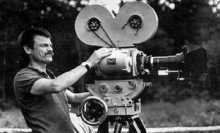Russian cinema is some of the most intriguing, yet it is often difficult to approach. Of all movie-making cultures, it's my opinion that those from the former Soviet bloc have approached the process most purely as art. This isn't necessarily a reflection of the culture, per se, but an unusual byproduct of what it meant to produce films under the various Soviet regimes.
To provide a crash course in the history of Soviet cinema (a deeply interesting topic for those who have the time and inclination to study it), here are a few fun facts: At the dawn of popular cinema, the Bolsheviks used to transport projection systems to rural areas so they could inspire the agrarian proletariat with pro-revolution films like Battleship Potemkin and Mother. For the frequently illiterate masses away from the bustling town centers of Russia's cities, the stirring images of Social Realist motion pictures weren't just entertainment, they were cultural education.
Later, Joseph Stalin reportedly reviewed every government-funded film produced during his regime. That would certainly account for the extremely flattering depictions of the Steel Man that are fairly ubiquitous in those movies. After Stalin, the Soviet government concerned itself less with the details of film production, though they still monitored the movies for content considered immoral or subversive. Watching Soviet films, especially from the 1970's, it becomes apparent that the censors weren't very good at their jobs, or that they were hopelessly corrupt. Indeed, many of these films are primarily subversive, however layered in symbolism and non-traditional storytelling.
The master of sneaky anti-authoritarian cinema was definitely Andrei Tarkovsky. Over the course of 30 years he produced eleven films, eight of which were made in and for the Soviet Union. He began by adapting Ernest Hemingway's The Killers as a student, making two more student films before his professional debut in 1962 with Ivan's Childhood. By the time he adapted Stanislaw Lem's book Solaris in 1972, Tarkovsky was in full-on Weird Mode. His films from that point on ranged from high-concept to non-narrative.
Tarkovsky, perhaps more than any director, requires an introduction. He's not quite as overtly mind-bending as, say, David Lynch, but he's still difficult to grasp from a traditional movie-going perspective. Tarkovsky is varsity-level Russian cinema and I'm dying to do a piece on The Mirror from 1975, but that's pretty much starting from the top of the Soviet art-film mountain. I'll definitely be coming back to Tarkovsky a few times over the course of this column. He's also a good point of reference for some other deeply weird movies that came out of places like Georgia in the same era. Especially when placed in stark contrast to blunt, Oscar-baiting dreck like Moscow Knows No Tears, the films of Andrei Tarkovsky are some of the finest works of modern art to ever come out of Russia.
Tarkovsky died in 1986 of lung cancer and there are a number of theories as to how he got it. His last Soviet film, Stalker, was shot on the grounds of an abandoned factory. Some of his close friends believed that hazardous waste from the location poisoned Tarkovsky, as well as his wife who was an assistant director on the film. Later, a conspiracy theory arose that the KGB actually radiated Tarkvosky for his subversive movies, but there is little credible evidence of this. Whatever the case, Andrei Tarkovsky died long before his career was over. Given a bit more time, he might have graced our shores with his particular brand of high cinema.
